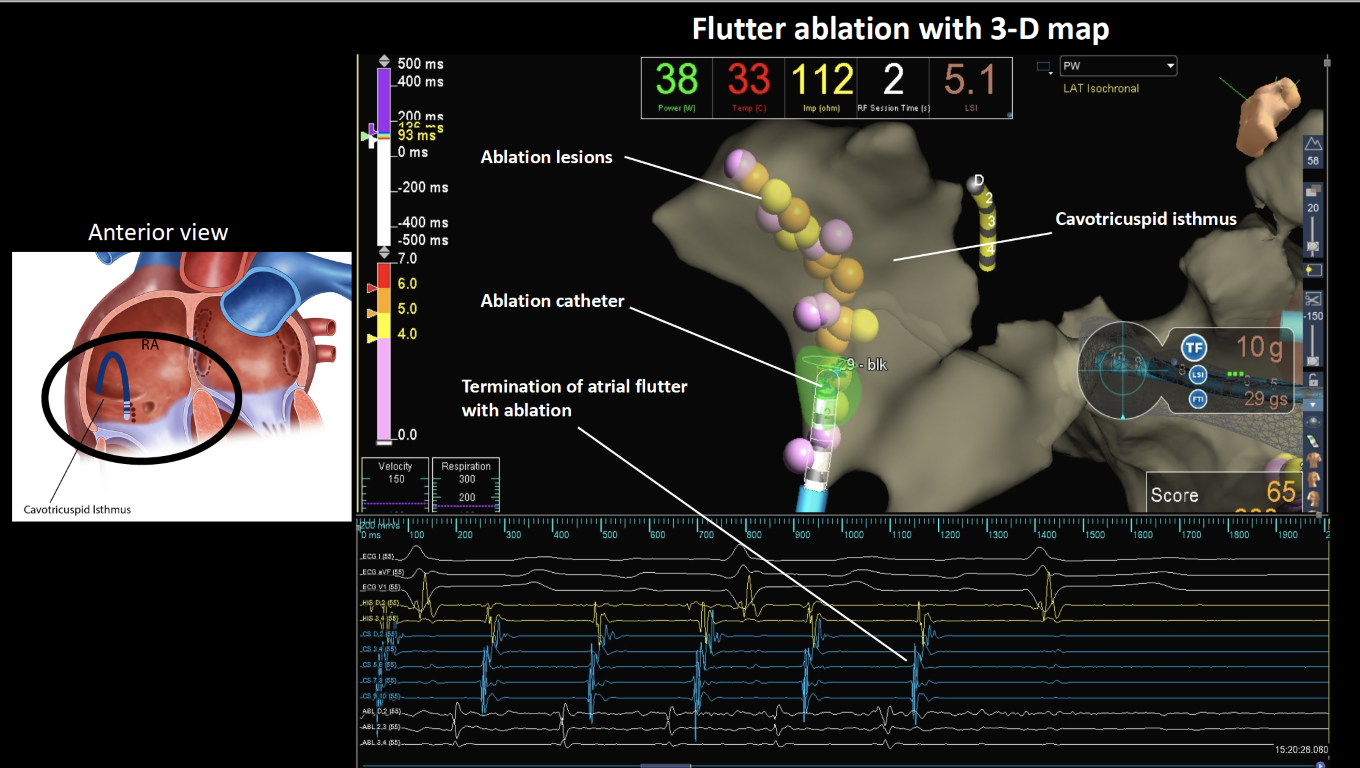Catheter ablation for typical (CTI) atrial flutter:
Catheter ablation for atrial flutter is an effective treatment. Procedural success is estimated at >95%. <5-10% may need to have this procedure again. More than 50% of people with atrial flutter develop AF at some stage. Please refer to the catheter ablation section for general information about the admission process and requirements.
What are the risks of having a flutter ablation?
They include but are not limited to the following.
Common risks and complications (more than 5%) include:
- Bruising bleeding at the puncture site. Bruising can extend beyond the puncture site and can take a few weeks to improve in some cases.
Uncommon risks and complications (1- 5%) include:
- Blood clot in the leg (DVT) causing pain and swelling. In rare cases part of the clot may break off and go to the lungs called pulmonary embolus.
- Damage to normal electrical system requiring a permanent pacemaker
Rare risks and complications (less than 1%) include:
- Injury to the food pipe related to the ultrasound or temperature probe used during the procedure.
- Death because of this procedure is rare
What happens during the procedure?

You will be transferred to the catheter laboratory and will have to lie on a narrow hard bed under the X-ray machine. The anaesthetist will usually get you off to sleep (general anaesthesia). Local anaesthetic is administered at the groin which numbs the area. Four small tubes called sheaths are passed into the vein in the right groin through which catheters are inserted and gently passed up until they reach your heart. An X-ray machine guides the catheters to your heart. A special ultrasound camera called a trans oesophageal echo (TOE) probe maybe advanced via your mouth into your oesophagus (gullet) that sits next to your heart. With this we check for any clots in the heart prior to any ablation. If a clot is found, the procedure will have to be abandoned. Additional blood thinners are usually given to thin the blood further to prevent a stroke. The TOE probe is usually removed. A mapping catheter maybe advanced into the RA to make a 3-D model which identifies the structures of relevance. An ablation catheter is advanced into the right atrium that applies the ablation energy around the cavotricuspid isthmus (CTI) to terminate the atrial flutter circuit.

The catheter ablation procedure can take 1 hr or more in some cases. In some cases, additional unexpected rhythms become apparent. You doctor will proceed to further ablation if required to prevent you having to return for a second procedure.
What happens after an ablation?
At the end of your procedure, your doctor will remove the catheters and apply pressure, followed by a simple dressing. You may have a little device applying pressure at the puncture site for a few hours. You’ll be watched closely in a recovery area, and depending on how you feel, you might need to rest in bed for a while. You will be admitted to the ward for observation overnight with rhythm monitoring. You are generally required to lay flat on your back for about 4 hours after your procedure. People are usually discharged the next day.
What happens after discharge?
Follow up:
- An appointment will be made for you to be seen in clinic about 2 months after the procedure
- If you do not receive a date for an appointment within 8 weeks, please call the clinic and ask to speak to the secretary
Medications:
- Continue your medications as instructed. If you are uncertain about your medications, please ring the rooms for clarification
- Your flutter medications may be discontinued following the ablation or weaned over 2-3 months
Postoperative care:
- Avoid strenuous exercise for 1 week
- Start with gentle exercise after 1 weeks – e.g. Long walks.
Symptoms to monitor:
It is not uncommon to have a bruise at the groin that extends / spreads after the ablation. This usually resolves over time without any other problems. You will need to be aware of the potential for AF in the future
Bleeding: It is rare to have severe bleeding from the puncture site once you are at home. If bleeding does occur you must: lie flat, apply pressure to the site for 10 minutes. If it continues, call an ambulance for assistance.
Please contact the rooms if you have any questions or concerns at any time.
In recommending this procedure your doctor has balanced the benefits and risks of the procedure against the benefits and risks of not proceeding. Your doctor believes there is a net benefit to you going ahead. This is a very complicated assessment.